
Standard of Care for Specifying Floors in Mission-Critical Spaces
[21 min read]
Post Sections
To prevent ESD failure in critical spaces, specifiers must look at flooring performance, safety, and industry compliance. Here’s what specifiers need to know.
Need additional information about specific ESD products? Learn more about the StaticWorx ESD flooring range.

Drafting a specification for static-control flooring means accepting responsibility for performing application-specific due diligence, involving electrical properties, grounding and even safety…
…professional Standard of Care requires the architect or specifier to identify, cite, and meet all applicable grounding standards, as mandated by the client’s industry.

The job of 9-1-1 dispatchers and call center operators is to respond to calls from people in need. But what happens when electrostatic discharge (ESD) interferes with ESD-sensitive communications equipment and the call is lost? Data jumbled? Or the network shut down?
Static-control flooring helps prevent random discharge from harming electronic equipment in mission-critical spaces. But if the floor doesn’t meet international industry standards—as well as the standard of care established by the American Institute of Architects (AIA)—dispatchers can’t do their job and callers may be frustrated or, in worst cases, put at risk.
Years of experience suggest that approximately 70% of the static-control floors installed in end-user environments such as 24/7 mission-critical call centers are improperly specified.
Why such a high level of faulty installation?
- The main culprit is a general lack of awareness regarding communication industry standards—common among not only facility managers but also professionals such as architects, engineers, other specifiers, as well as contractors who install flooring. Even most flooring manufacturers often don’t have the right technical information.
- Lack of information can lead to misinformation. Manufacturers and distributors sometimes confuse buyers by incorrectly recommending products that don’t meet the latest standards. Unsuspecting specifiers read marketing claims and, without due diligence or extensive research, assume the information is technically valid.
- Industry standards are also subject to change. Electrical engineers are typically the only people familiar with important revisions that impact the selection of static-protective flooring. Unless there’s an informed EE, or someone with a similar level of knowledge on or heading the selection committee, it’s easy to miss crucial changes.
Care, Caution, and Correct Conductivity
 Architects and others who write specifications for emergency call centers, radio dispatch sites, PSAPs, and other mission-critical spaces requiring uninterrupted operation should exercise care and caution when specifying grounded flooring. Failure to do so can result in ramifications related to performance, electrical safety, compliance, and liability.
Architects and others who write specifications for emergency call centers, radio dispatch sites, PSAPs, and other mission-critical spaces requiring uninterrupted operation should exercise care and caution when specifying grounded flooring. Failure to do so can result in ramifications related to performance, electrical safety, compliance, and liability.
Performance: The ESD floor must meet the requirements of the application, ground static charges, and prevent charge generation. In mission-critical spaces, this means choosing a floor that will prevent static on people wearing any kind of footwear.
- Many static-control floors—vinyl, epoxy, and interlocking plastic tiles, for instance—are intended for use with special static-preventive footwear. Independent studies, conducted by Bell Labs, have shown that static-dissipative carpet and rubber floors inhibit static regardless of footwear.
Safety: A static-control floor establishes an electrical connection between people walking on the floor and ground. If it will be used in a space housing electrified equipment, the floor can’t be too conductive: currents from stray voltage or other electrical problems could shoot across its surface, inadvertently making people on the floor or working near the equipment part of a closed electrical circuit.
- A “low-resistance” conductive carpet might eliminate static discharges, but it may be too conductive to be installed safely around electrified equipment.
- Note: 1 million ohms (1.0 x 10E6) is the standard minimum resistance value for most mission-critical spaces, including call centers, 9-1-1 dispatch operations, and flight-control towers. The correct electrical resistance should be specified, tested, and verified in writing after the floor is installed.
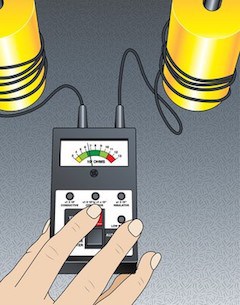 Compliance and Standard of Care: Any static-control floor is also a grounded pathway for electricity. Based on the specifier’s or architect’s due diligence, the floor should meet appropriate industry grounding standards, comply with state and local codes, and meet the needs of the client. Motorola R56 and ATIS 0600321 are considered the definitive guides to site grounding and electrical protection for communication sites like 9-1-1 dispatcher operations (see below). These standards clearly define the best-practice ohms resistance measurements for mission-critical centers, and both recommend at least 1 million ohms (1.0 x 10E6).
Compliance and Standard of Care: Any static-control floor is also a grounded pathway for electricity. Based on the specifier’s or architect’s due diligence, the floor should meet appropriate industry grounding standards, comply with state and local codes, and meet the needs of the client. Motorola R56 and ATIS 0600321 are considered the definitive guides to site grounding and electrical protection for communication sites like 9-1-1 dispatcher operations (see below). These standards clearly define the best-practice ohms resistance measurements for mission-critical centers, and both recommend at least 1 million ohms (1.0 x 10E6).
Liability: At home, safeguards such as ground fault interrupters and building code inspections protect against electrical shock and potentially harmful situations. But what about safeguards in the workplace? The fact is, manufacturers, installers, and specifiers can be held liable for any damage or harm their products might cause.
 In an article published by In Compliance Magazine in January 2012, nationally known liability attorney Kenneth Ross states, “Industry standards and even certifications like UL are considered minimum. As a result, compliance with standards and certifications is not an absolute defense, although it is pretty good evidence that the product was reasonably safe. Therefore, as with laws and regulations, the plaintiff can argue that you should have exceeded the standards. However, noncompliance is a problem if it caused or contributed to the injury. The reason is that the standard establishes a reasonable alternative design and the manufacturer has to justify why it didn’t comply.”
In an article published by In Compliance Magazine in January 2012, nationally known liability attorney Kenneth Ross states, “Industry standards and even certifications like UL are considered minimum. As a result, compliance with standards and certifications is not an absolute defense, although it is pretty good evidence that the product was reasonably safe. Therefore, as with laws and regulations, the plaintiff can argue that you should have exceeded the standards. However, noncompliance is a problem if it caused or contributed to the injury. The reason is that the standard establishes a reasonable alternative design and the manufacturer has to justify why it didn’t comply.”
In the case of ESD flooring, reasonable alternatives to unsafe or non-performing static-control floors certainly exist. In looking for the best solution, as noted above, it is prudent to exceed safety and electrical thresholds and never specify a lower electrical resistance than standards and compliance documents recommend. To ensure electrical performance, it’s crucial to understand ESD terminology, industry standards and test methods, and to evaluate the environmental conditions and the use (or lack of) static-protective footwear.
While some buyers or sellers insist—correctly—that serious shocks from a highly conductive floor are unlikely, a quick Google search will turn up many documented cases of people receiving serious, even deadly, shocks from electrified manhole or utility service covers. An electrical short circuit can do the same to someone standing on wet concrete. The same principle applies to people standing or working on an overly conductive floor.
Suppose a room is outfitted with a server or telecom switch operating at 220 volts. If a person—repairing a server, for instance—is exposed to an open circuit while grounded to the conductive floor, the voltage could cause a dangerous or even lethal shock.

Architects and others who write specifications for emergency call centers, radio dispatch sites, PSAPs, and other mission-critical spaces requiring uninterrupted operation should exercise care and caution when specifying grounded flooring. Failure to do so can result in ramifications related to performance, electrical safety, compliance, and liability.
Performance: The ESD floor must meet the requirements of the application, ground static charges, and prevent charge generation. In mission-critical spaces, this means choosing a floor that will prevent static on people wearing any kind of footwear.
- Many static-control floors—vinyl, epoxy, and interlocking plastic tiles, for instance—are intended for use with special static-preventive footwear. Independent studies, conducted by Bell Labs, have shown that static-dissipative carpet and rubber floors inhibit static regardless of footwear.
Safety: A static-control floor establishes an electrical connection between people walking on the floor and ground. If it will be used in a space housing electrified equipment, the floor can’t be too conductive: currents from stray voltage or other electrical problems could shoot across its surface, inadvertently making people on the floor or working near the equipment part of a closed electrical circuit.
- A “low-resistance” conductive carpet might eliminate static discharges, but it may be too conductive to be installed safely around electrified equipment.
- Note: 1 million ohms (1.0 x 10E6) is the standard minimum resistance value for most mission-critical spaces, including call centers, 9-1-1 dispatch operations, and flight-control towers. The correct electrical resistance should be specified, tested, and verified in writing after the floor is installed.

Compliance and Standard of Care: Any static-control floor is also a grounded pathway for electricity. Based on the specifier’s or architect’s due diligence, the floor should meet appropriate industry grounding standards, comply with state and local codes, and meet the needs of the client. Motorola R56 and ATIS 0600321 are considered the definitive guides to site grounding and electrical protection for communication sites like 9-1-1 dispatcher operations (see below). These standards clearly define the best-practice ohms resistance measurements for mission-critical centers, and both recommend at least 1 million ohms (1.0 x 10E6).
Liability: At home, safeguards such as ground fault interrupters and building code inspections protect against electrical shock and potentially harmful situations. But what about safeguards in the workplace? The fact is, manufacturers, installers, and specifiers can be held liable for any damage or harm their products might cause.

In an article published by In Compliance Magazine in January 2012, nationally known liability attorney Kenneth Ross states, “Industry standards and even certifications like UL are considered minimum. As a result, compliance with standards and certifications is not an absolute defense, although it is pretty good evidence that the product was reasonably safe. Therefore, as with laws and regulations, the plaintiff can argue that you should have exceeded the standards. However, noncompliance is a problem if it caused or contributed to the injury. The reason is that the standard establishes a reasonable alternative design and the manufacturer has to justify why it didn’t comply.”
In the case of ESD flooring, reasonable alternatives to unsafe or non-performing static-control floors certainly exist. In looking for the best solution, as noted above, it is prudent to exceed safety and electrical thresholds and never specify a lower electrical resistance than standards and compliance documents recommend. To ensure electrical performance, it’s crucial to understand ESD terminology, industry standards and test methods, and to evaluate the environmental conditions and the use (or lack of) static-protective footwear.
While some buyers or sellers insist—correctly—that serious shocks from a highly conductive floor are unlikely, a quick Google search will turn up many documented cases of people receiving serious, even deadly, shocks from electrified manhole or utility service covers. An electrical short circuit can do the same to someone standing on wet concrete. The same principle applies to people standing or working on an overly conductive floor.
Suppose a room is outfitted with a server or telecom switch operating at 220 volts. If a person—repairing a server, for instance—is exposed to an open circuit while grounded to the conductive floor, the voltage could cause a dangerous or even lethal shock.
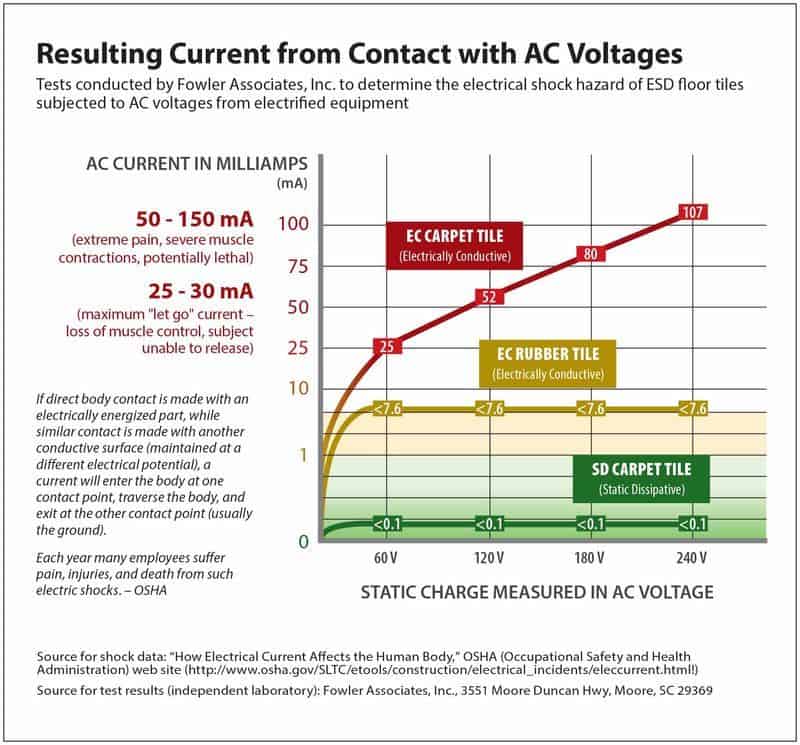
So, yes, a serious or deadly shock is highly unlikely, but one accident is one too many.
Motorola R56, ATIS 0600321, and FAA 019f are well known, readily available standards in existence for years. As all recommend a minimum resistance of 1.0 x 10E6, an electrical accident involving a non-compliant floor would leave the specifier defenseless.
Ohm's Law and Fluctuating Resistivity
Ohm’s Law is a mathematical formula used to calculate the relationships among voltage (v)—applied at point A on an electrical circuit—the current (i), measured in amps, flowing between points A and B, and the resistance (r), measured in ohms, in its path. According to Ohm’s Law, current is directly proportional to voltage and inversely proportional to resistance.
Using the Ohm’s Law formula, resulting current is calculated by dividing the applied voltage by the resistance (I = V/R) of the material. Applying 220-volts to floor tiles with a resistance of 25,000 ohms should result in an 8.8-milliamp current.
220 volts ÷ 25,000 ohms = .0088 amps (8.8 mA)
A person exposed to an 8.8-milliamp current would feel a painful shock and could begin to lose muscular control.*
* Electrical current between 9 and 30 milliamps is known as the freezing current, commonly referred to as the “let-go” range-meaning that the person could not let go of the energized part, but could be thrown away from the circuit.
Effects of Electric Current in the Human Body
| Current | Reaction |
|---|---|
| Below 1 milliampere | Generally not perceptible |
| 1 milliampere | Faint tingle |
| 5 milliamperes | Slight shock felt; not painful but disturbing. Average individual can let go. Strong involuntary reactions can lead to other injuries. |
| 6–25 milliamperes (women) | Painful shock, loss of muscular control* |
| 9–30 milliamperes (men) | The freezing current or ” let-go” range.* Individual cannot let go, but can be thrown away from the circuit if extensor muscles are stimulated. |
| 50–150 milliamperes | Extreme pain, respiratory arrest, severe muscular contractions. Death is possible. |
| 1,000–4,300 milliamperes | Rhythmic pumping action of the heart ceases. Muscular contraction and nerve damage occur; death likely. |
| 10,000 milliamperes | Cardiac arrest, severe burns; death probable |
* If the extensor muscles are excited by the shock, the person may be thrown away from the power source.
Source: OSHA, “Effects of Electric Current in the Human Body”
Calculated Versus Actual Current
To investigate potential safety concerns with overly conductive floor tiles, ESD industry analyst Steve Fowler,* performed electrical current testing in a controlled lab environment. In the test, 120 volts of AC current was applied to various materials.
* Steve Fowler is president of Fowler Associates, Inc., and publisher of the ESD Journal.
Ohm’s Law calculations tell us that applying 120 volts to a material with an electrical resistance of 50,000 ohms (5.0 x 10E4) will result in a current of .0024 amps or 2.4 milliamps (mA).
Calculated Current: 120 (v) ÷ 50,000 (r) = .0024 (i)
In the lab, the actual resulting current measured 22 milliamps—nearly 10 times higher than predicted by Ohm’s Law. In fact, every material tested in the lab generated currents 7 – 9 times greater than predicted by calculations based on Ohm’s Law.
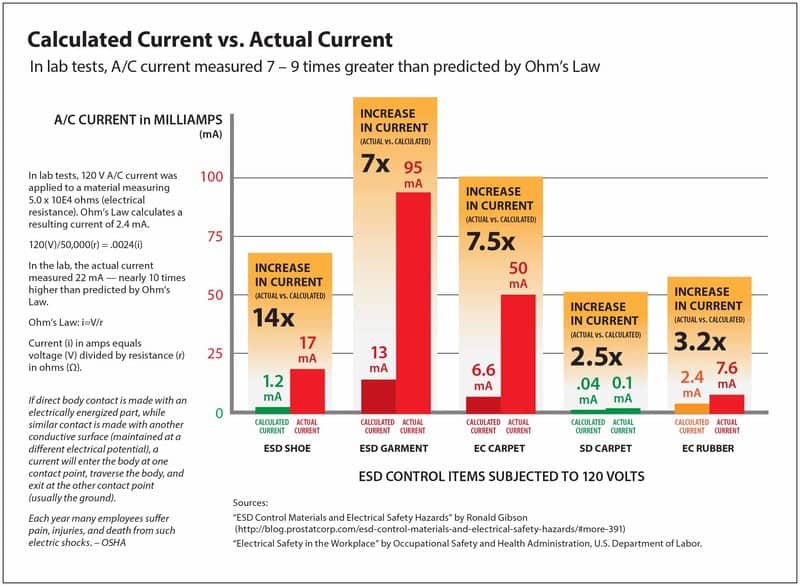

Fluctuating Resistance in Real-World Conditions
After an ESD floor is installed, factors such as wet shoe soles, high moisture, or high RH can lower its resistance, creating an even faster path to ground than predicted by tests done in a lab.
Remember: current is inversely proportional to resistance.
As we know, water is a conductor; water and relative humidity (RH) lower the electrical resistance of most flooring materials.
In wet, humid conditions, an ESD flooring material specified as having an average resistance of 25,000 ohms (2.5 x 10E4) could measure 10,000 ohms or less. At 10,000 ohms, 220 volts could expose a person on the floor to an electrical current of 220 milliamps (based on Ohm’s Law; in actuality, 7 – 9 times higher).
220 (v) ÷ 10,000 (r) = .022 (i)
The same 220 volts on a static-dissipative floor measuring above 1.0 x 10E6 (1,000,000 Ω), meeting FAA 019f and Motorola R56, would generate only .22 milliamps of current—1/1000th the current allowed by the overly conductive floor.
220 ÷ 1,000,000 = .00022 (i)
Multiplied by a factor of 10, resulting current would still be well within the safe range outlined by OSHA. This is why standards organizations require a minimum resistance of 1 million ohms (10E6) in spaces where people work with operational equipment.
- This link to an Ohm’s Law calculator allows you to mathematically determine electrical current based on the resistance of floors that might be used around energized equipment and appliances.
- Note: Keep in mind that in actual installations, environmental factors such as moisture, RH, and wet shoes can and will reduce the resistance of any static-control floor. When resistance is reduced, electrical current increases.
Test Method Used in Lab Tests Conducted by Fowler and Associates, Inc.
Read the Fowler Associate Study
The voltage was controlled by a variac feeding a step-up transformer. Applied voltage was measured with a standard multimeter, and AC current with a clamp-on style ammeter.
The voltage was raised slowly, using an AC power supply, and the volts recorded for several “milestone” currents. Data from these empirical tests supported the fact that actual, or real world, AC currents are much higher than currents predicted using an Ohm’s Law calculation.
For example, the conductive carpet supported 15 milliamps—the maximum let-go current—at a mere 42 volts. The same tests performed on a static-dissipative (> 1.0 x 10E6) carpet tile measured .1 milliamps of current.
- According to Fowler, electrical codes require Ground Fault Interrupter outlets when the floor’s conductivity might allow over 5 milliamps.
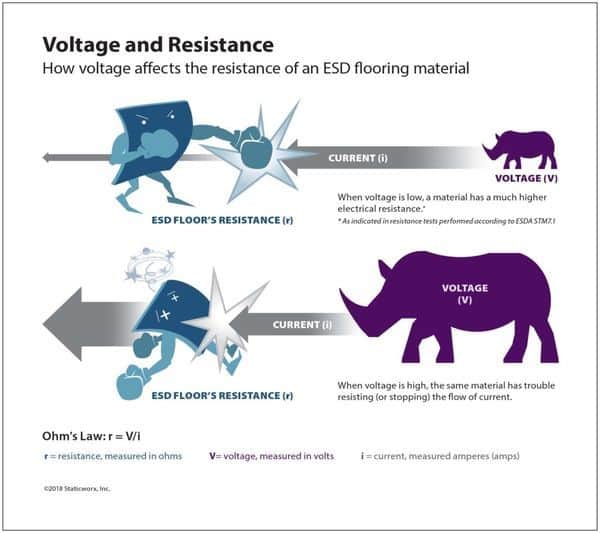
✓ visual selector guide;
✓ walking body voltage/low static generation;
✓ resistance requirements and testing;
✓ ESD flooring comparison;
✓ industry standards & test methods;
✓ key ESD terms
Electrical Standards
With industry-approved standards readily accessible, mistakes are easy to avoid. Look for standards that specifically address communications and telecom environments. To satisfy the expected standard of care, specifiers must know and comply with the latest standards.
ESD standards like ANSI/ESD S20.20 used in electronics manufacturing are not relevant to communications operations.
Motorola R56
The Motorola guidelines have become the recognized standard in the telecom industry and serve as the most complete and rigorous specification for the protection of communication system equipment installed at public safety and commercial wireless communication sites.
Excerpt from Appendix C 3.3 – 68P81089E50-B: “Carpeting or floor tiles within an equipment room or dispatch center, including raised flooring, should have a resistance to ground measurement of between 1,000,000 and 1,000,000,000 ohms.”
As noted, standards are subject to change based on the latest research. Several years ago, the standards committee at Motorola released a revision of R56 adding a recommendation to conduct flooring audits to ensure proper compliance. To protect clients and themselves, many electrical engineering spec writers include this requirement in their specifications.
ATIS 0600321 (Alliance for Telecommunications Industry Solutions)
ATIS publishes standards for the information, entertainment, and communications industries.
Excerpt from Section 4.2 Flooring: “Any carpeting or floor tiles should have a resistance to ground between 10E6 and 10E10 ohms when measured using the method of ESD-S7.1.”
FAA 019f
FAA grounding standard STD 019f, which sets guidelines for flight-control towers, also recommends a resistance range of between 1 million (10E6) and one billion (10E9) ohms for flooring used in flight-control towers and around flight-control equipment.
Section 4.1.3.3.2 Static Conductive Materials Those materials with a surface resistivity less than 1.0 x 10E5 ohms/square when tested per ANSI/ ESD S11.11 shall be considered conductive. Conductive ESD control materials shall not be used for ESD control work surfaces, tabletop mats, floor mats, flooring, or carpeting where the threat of personnel contact with energized electrical or electronic equipment exists.
Note: the FAA’s document 019f supersedes a previous document (019d) where conductive flooring was considered acceptable.
Low Charge Generation: A Crucial Factor
In a mission-critical space it’s not enough to specify a floor that meets standards for electrical ohms resistance. The floor must also prevent static from building as people walk.
The biggest contributor to damage from static discharge in any environment comes from the charges generated when people walk on the floor. When we walk, the friction between the floor and the soles of our shoes generates static. As we continue to walk, static builds on our body and discharges to the first person or object we touch. This sudden transfer of electrical current can fry or alter the microcircuits inside electronic components.
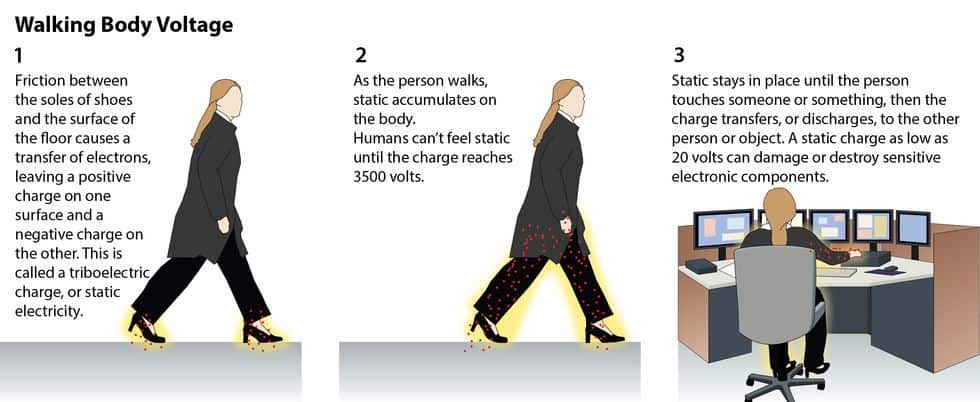

How ESD Flooring Works
Conductive additives—carbon fibers or conductive filaments—added to ESD flooring materials in the manufacturing process create an electrical connection between the floor and the shoe soles of people walking across the floor. These conductive elements draw charges through the thickness of the floor, across the conductive ground plane, to ground.
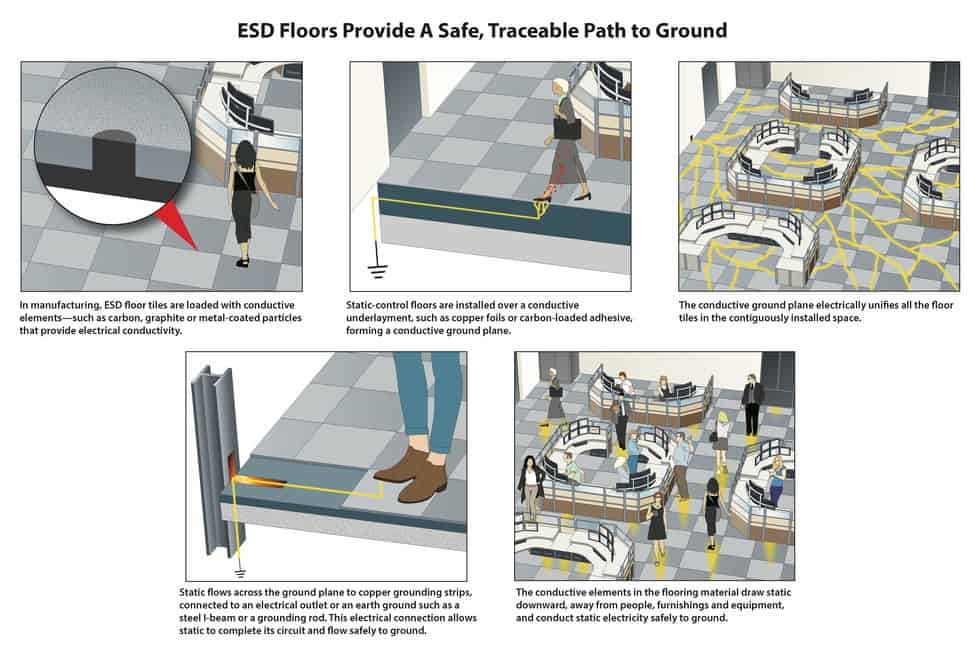

Conductivity Does Not Prevent Static Generation
The conductive elements in a flooring material draw static to ground. But conductivity is only half the story. The other half concerns charge generation. Charge generation refers to the amount of static that’s generated when people walk across the floor (walking body voltage).
In the past, static-control standards prioritized the testing of a floor’s conductivity over testing its charge generation properties. It was assumed that the more conductive a floor measured, the more likely that floor was to prevent charge generation. That line of thinking was eliminated several years ago for sound reasons.
Since 2014, ANSI/ESD S20.20 has required charge generation testing regardless of conductivity. The selection process should always include testing for charge generation with the types of footwear that will likely be worn in the space.
Research and job-site audits have shown over and over again that conductivity and charge generation are unrelated performance parameters. If someone wearing standard footwear—athletic shoes with insulative soles, for example—walks on certain conductive floors, the floor will generate static charges on the soles of the person’s shoes. This is because the chemical or material makeup of some conductive flooring materials—ESD vinyl and epoxy, for instance—is triboelectrically incompatible with the soles of most street shoes.
No matter how conductive a floor might be, if it’s not a low charge-generating material it won’t dissipate charges quickly enough to prevent static build up on people as they walk across the floor. Charge-generating ESD floors protect components from static events only if every person in the environment wears special ESD-protective footwear at all times.
With the exception of conductive rubber and some ESD carpet, all static-control flooring generates static on people wearing street shoes. ESD vinyl and epoxy are not suitable for use in mission-critical spaces where footwear is not controlled.
Conductive (EC) rubber, with a triboelectric propensity that’s close to the soles of most street shoes, is a naturally low static-generating material. EC rubber is the only resilient flooring material that prevents static generation regardless of the shoes people are wearing.
In mission-critical spaces, where the minimum voltage standards are higher than the <20 V required for electronics manufacturing, ESD carpet will also generate acceptably low-voltage charges on people wearing street shoes.
Low Charge Generation Key to Preventing Static Buildup
 In the electronics manufacturing and handling industry, people are required to wear special, static-protective footwear—such as heel straps, toe straps, or ESD shoes. The conductivity of ESD footwear creates an electrical bond between the wearer, shoe soles, and the surface of the floor, preventing static generation and buildup as the person walks.
In the electronics manufacturing and handling industry, people are required to wear special, static-protective footwear—such as heel straps, toe straps, or ESD shoes. The conductivity of ESD footwear creates an electrical bond between the wearer, shoe soles, and the surface of the floor, preventing static generation and buildup as the person walks.
To prevent static events, either every person who walks through the space must wear special static-protective footwear at all times, or the floor must be low charge-generating. In class 0 ESD handling, manufacturing, and R&D, management requires a low-generating flooring material and compliance to ESD-controlled footwear mandates.
In spaces where special ESD footwear is mandated and mandates are enforced, most ESD flooring materials will get the job done, in which case the decision comes down to factors such as budget, appearance, ergonomics, noise attenuation, durability (with regards to solvents or chemical spills, high traffic, or heavy loads), and maintenance concerns.
In mission-critical spaces, in which people wear regular, non-ESD street shoes, it’s crucial to prevent static in the first place. This means, to protect components and keep the space operational, mission-critical areas must be covered with low charge-generating materials.
Based on a recent comprehensive study by ASHRAE of ESD floors for data centers, the working maximum allowable static charge is now 500 volts or .5 kV. This limit eliminates almost all types of flooring, making static dissipative carpet and ESD rubber the only ideal options for static control.
ASHRAE: “The ASHRAE group has established 500 volts as the maximum level on personnel for service operations.”
Due Diligence
When specifying an ESD floor for mission-critical spaces, it’s imperative to communicate clearly and exercise due diligence to make the right decisions. Accurate, industry-tested information will lead to intelligent choices, reducing the risk to all involved—from the specifier, to the flooring installer, to the property owner/manager, to anyone on the floor.
Exercising due diligence means doing your research:
- Comparing the claims of product marketers with the recommendations of R56, ATIS, and the FAA.
- Testing any floor under consideration to be sure it meets all industry-required standards.
- Comparing materials and understanding the difference between conductivity and low charge generation.
Due diligence may also include testing the expectations of the client. The client may lack the technical knowledge or language to adequately describe the situation they need to address or identify the correct product for their application—leaving the specifier to fill in the blanks.
Time equals money, yes, but weighed against the costs of replacing a non-compliant floor or defending a lawsuit, the effort and energy expended on due diligence is time well spent.
Design professionals and specifiers, such as architects and engineers, are judged in two ways: by the details of the contract between the owner and the professional, and by the professional Standard of Care.
Specifying a static-control floor means accepting responsibility for the performance and safety of the ESD floor, which requires the architect or specifier to identify, cite, and meet all specific applicable standards, as mandated by the client’s industry.
An earlier version of this article appeared in 9-1-1 Magazine, in May, 25, 2012.
Additional Information
- References
- Standards
-
Safety Risk with Overly
Conductive Carpet -
How to Test AC
Current Potential
- NIOSH [1998]. Worker Deaths by Electrocution; A Summary of NIOSH Surveillance and Investigative Findings. Ohio: US Health and Human Services.
- Greenwald EK [1991]. Electrical Hazards and Accidents – Their Cause and Prevention. New York: Van Nostrand Reinhold.
- Fowler Associates, Inc: Electrocution Hazard From Conductive Carpet Tiles
Why would a conductive carpet cause concern for safety?
In a recent white paper, Ronald Gibson, a retired ESD program manager from Celestica Corporation, pointed out that measurements from DC resistance meters should never be used to determine if a grounded floor is safe or unsafe. Gibson provided examples demonstrating that actual (as opposed to calculated) AC electrical currents can be much higher than one would predict by calculating current using ohm meter readings and inserting them into an Ohms Law equation. In Gibson’s example below, the true AC current (22 milliamps) is actually nine times greater than the calculated current of 2.4 milliamps.
Note: Calculated current is computed using Ohm’s Law. Current equals voltage divided by resistance. 120 volts divided by 50,000 ohms = .0024 or 2.4 milliamps. In theory, this means that a 50,000 ohm material would only deliver 2.4 milliamps when subjected to 120 volts AC power.
| Item | Condition | Voltage | Current | Resistance |
|---|---|---|---|---|
| Conductive Scrim inside Table Covering | Current limited Resistance Meter Reading | 10 | 200 uA | 5.0 x 10E4 |
| Calculated current based on Ohm’s Law | 120 | 2.4 milliamps | 5.0 x 10E4 | |
| Actual AC current | 120 | 22 milliamps | 5.4 x 10E3 | |
| Increase in current | Actual current 9 times higher than predicted |
Conductive carpet carries electrical currents over 4 times the lethal limit recognized by OSHA
Based on Gibson’s comments we sought the services of an electrical engineering lab to subject conductive and static dissipative carpet tiles to this same type of scrutiny. The lab’s findings concurred with the data Gibson provided in his paper on electrical safety. As predicted, static dissipative flooring allowed far less current than conductive flooring.
In these tests, the amount of current delivered through a conductive carpet tile was measured above 50 milliamps. OSHA cites 16 milliamps as the level of current where a person’s muscles would contract and prevent them from letting go of the electrified object. The AC current measured across conductive carpet tile was over three times that amount. 50 milliamps is considered a “fatal current.” Since studies have shown that conductive carpet offers no performance advantage over static dissipative carpet, there is no incentive for its use.
| Item | Condition | Voltage | Current | Resistance |
|---|---|---|---|---|
| Conductive Carpet with PVC-Free Backing | Current limited Resistance Reading | 10 | 200 uA | 18,000 |
| Calculated current based on Ohm’s Law | 120 | 6.6 milliamps | 18,000 | |
| Actual AC current | 120 | 50 milliamps Potentially fatal | 18,000 | |
| Dissipative Carpet with PVC Backing | Current limited Resistance Reading | 100 | 200 uA | 3.0 x 106 |
| Calculated current based on Ohm’s Law | 120 | 0.4 milliamps | 3.0 x 106 | |
| Actual AC Current | 120 | < .1 milliamp | 3.0 x 106 |
The tile was placed on a large piece of aluminum foil. A 5 pound electrode was placed on top of the tile. The A.C. voltage was applied from the top electrode to the aluminum foil.
The voltage was controlled by a variac feeding a step-up transformer. The voltage applied was measured with a standard multimeter. The A.C. current was measured with a clamp-on style ammeter.
The voltage was raised slowly and the volts recorded for several “milestone” currents.
- NIOSH [1998]. Worker Deaths by Electrocution; A Summary of NIOSH Surveillance and Investigative Findings. Ohio: US Health and Human Services.
- Greenwald EK [1991]. Electrical Hazards and Accidents – Their Cause and Prevention. New York: Van Nostrand Reinhold.
- Fowler Associates, Inc: Electrocution Hazard From Conductive Carpet Tiles
Why would a conductive carpet cause concern for safety?
In a recent white paper, Ronald Gibson, a retired ESD program manager from Celestica Corporation, pointed out that measurements from DC resistance meters should never be used to determine if a grounded floor is safe or unsafe. Gibson provided examples demonstrating that actual (as opposed to calculated) AC electrical currents can be much higher than one would predict by calculating current using ohm meter readings and inserting them into an Ohms Law equation. In Gibson’s example below, the true AC current (22 milliamps) is actually nine times greater than the calculated current of 2.4 milliamps.
Note: Calculated current is computed using Ohm’s Law. Current equals voltage divided by resistance. 120 volts divided by 50,000 ohms = .0024 or 2.4 milliamps. In theory, this means that a 50,000 ohm material would only deliver 2.4 milliamps when subjected to 120 volts AC power.
| Item | Condition | Voltage | Current | Resistance |
|---|---|---|---|---|
| Conductive Scrim inside Table Covering | Current limited Resistance Meter Reading | 10 | 200 uA | 5.0 x 10E4 |
| Calculated current based on Ohm’s Law | 120 | 2.4 milliamps | 5.0 x 10E4 | |
| Actual AC current | 120 | 22 milliamps | 5.4 x 10E3 | |
| Increase in current | Actual current 9 times higher than predicted |
Conductive carpet carries electrical currents over 4 times the lethal limit recognized by OSHA
Based on Gibson’s comments we sought the services of an electrical engineering lab to subject conductive and static dissipative carpet tiles to this same type of scrutiny. The lab’s findings concurred with the data Gibson provided in his paper on electrical safety. As predicted, static dissipative flooring allowed far less current than conductive flooring.
In these tests, the amount of current delivered through a conductive carpet tile was measured above 50 milliamps. OSHA cites 16 milliamps as the level of current where a person’s muscles would contract and prevent them from letting go of the electrified object. The AC current measured across conductive carpet tile was over three times that amount. 50 milliamps is considered a “fatal current.” Since studies have shown that conductive carpet offers no performance advantage over static dissipative carpet, there is no incentive for its use.
| Item | Condition | Voltage | Current | Resistance |
|---|---|---|---|---|
| Conductive Carpet with PVC-Free Backing | Current limited Resistance Reading | 10 | 200 uA | 18,000 |
| Calculated current based on Ohm’s Law | 120 | 6.6 milliamps | 18,000 | |
| Actual AC current | 120 | 50 milliamps Potentially fatal | 18,000 | |
| Dissipative Carpet with PVC Backing | Current limited Resistance Reading | 100 | 200 uA | 3.0 x 106 |
| Calculated current based on Ohm’s Law | 120 | 0.4 milliamps | 3.0 x 106 | |
| Actual AC Current | 120 | < .1 milliamp | 3.0 x 106 |
The tile was placed on a large piece of aluminum foil. A 5 pound electrode was placed on top of the tile. The A.C. voltage was applied from the top electrode to the aluminum foil.
The voltage was controlled by a variac feeding a step-up transformer. The voltage applied was measured with a standard multimeter. The A.C. current was measured with a clamp-on style ammeter.
The voltage was raised slowly and the volts recorded for several “milestone” currents.


Get in Touch
The form below will help us better understand your needs and get you as quickly as possible to the right person. We look forward to helping you solve your static problem!
You can expect a response within 24 hours. For faster service, please give us a call: 617-923-2000
"*" indicates required fields
Visit our privacy policy to find out how we process data.
Learning Center Articles
- ESD Basics
- Installation & Maintenance
- Selecting & Specifying an ESD Floor
- Technical Information
- 7 Common Mistakes Selecting an ESD floor
- A Guide to ESD Flooring Selection
- Avoid Costly Failures: What You Need to Know When Specifying ESD Flooring
- Choosing ESD Flooring for:
- ESD Footwear: What Is It and When Is It Necessary?
- ESD Footwear for Electronics Manufacturing and Handling Applications
- Facility Managers’ Guide to Selecting ESD Flooring
- The Need for Due Diligence in Specifying Static-Free Flooring
- Standard of Care for Specifying Floors in Mission-Critical Spaces
- Understanding the Hidden Costs of ESD Flooring

StaticWorx high-performance static-control floors protect electronic components, explosives, and high-speed computers from damage caused by static electricity. ESD flooring is part of a system. Choices should always be based on objective, researched evidence. When you partner with us, we look at all possible items that may need to integrate with the floor, and, focusing on your goals and objectives, help you find the right floor for your application.










